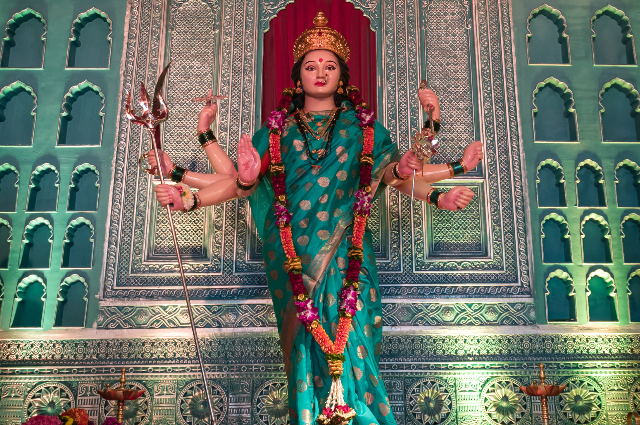
Introduction:
Navaratri is a Hindu festival purely dedicated to Goddess Durga. Navaratri is celebrated for nine nights. Nine divine incarnations of Goddess Durga are invoked and worshipped for nine days. According to Hindu mythology there are four Navaratris. They are Ashada Navaratri, Sharada Navaratri, Magha Navaratri and Vasanta Navaratri. Of them, Sharada Navaratri during autumn equinox and Vasanta Navaratri during spring equinox are popular.
Energy Aspects:
During Navaratri the energy aspects of the Trinity i.e. Brahma, Vishnu and Shiva are worshipped to keep the eternal processes of creation, preservation and destruction active. Maha Durga or Maha Kali, Maha Lakshmi and Maha Saraswati, consorts of Lord Shiva, Lord Vishnu and Lord Brahma, are the three female counterparts as well as the energy aspects of the Trinity. Actually, Shakti is worshipped in Her three different forms or the energy aspects of Trinity. Therefore, the first three days of Navaratri are dedicated to Maha Durga, second three days to Maha Laxmi and third three days to Maha Saraswati.
Symbolisms:
Maha Durga symbolizes the extermination of the original sins including Kama (lust), Krodha (anger), Lobha (greed), Mada (pride), Moha (attachment) and Matsarya (jealousy) and so on. She is adored in the forms of Her three incarnations which are Shailaputri, Brahmacharini and Chandraghanta during the first three days of Navaratri. During the second three days of Navaratri, Maha Lakshmi symbolizing material and spiritual prosperity is worshipped in Her three incarnations. They are Kushmanda, Skandamata and Katyayani as well. During the last three days of Navaratri, Maha Saraswati symbolizing spiritual knowledge is worshipped in Her three different incarnations. They are Kaal Ratri, Maha Gauri and Siddhidatri.
1. Pratipada:

The first day of Navaratri also known as Pratipada is dedicated to the incarnation of Shailaputri or the daughter of mountain. There are other nomenclatures like Parvati, Hemavati etc of this incarnation of the goddess Durga. She, the embodiment of the coalescence of the Trinity is depicted as a divine maiden riding on a bull with Her two hands wearing the attributes of a trident and a lotus. She in Her previous birth was Sati, the daughter of Daksha. Sati sacrificed Her life by self-immolation as a mark of protest against the humiliation of Lord Shiva, Her consort. Next birth She was born as the daughter of Himalaya. Shailaputri represents the Muladhara Chakra. Her divine journey in search of Her husband Shiva in her previous birth is regarded as the awakening of Shakti. The day is considered the beginning for Yogis to concentrate in meditation. The colour of the day is crimson symbolising action and vigour.
2. Dwitiya:

On the day of Dwitiya, the second day of Navaratri, Devi Durga is worshipped in the incarnation of Brahmacharini i.e. a maiden practicing rigorous penance and austerity. In this incarnation She is depicted as bare footed and with Her two hands holding a rosary and a kamandalu (holy water pot). According to myths, the maiden Parvati craved Shiva who was in deep meditation as Her consort. The cupid god Kamdev tried to evoke the eroticism of Lord Shiva for Parvati was infatuated with Him during Her previous birth. Then livid Shiva reduced Kamdeva to ashes. But Parvati was not disappointed. She took the path of asceticism like Lord Shiva who finally accepted Her as His wife. Brahmacharini symbolizing bliss and calm is worshipped for attaining Moksha (emancipation from the cycle of death and rebirth). The colour of the day is blue representing peace and prosperity.
3. Tritiya:

Chandraghanta, the incarnation of beauty and bravery, is adored on the third day of Navaratri craving for peace and prosperity. Chandra or moon dangling like a ghanta or bell from her forehead named Her Chandraghanta. This form of Devi is also known as Ranachandi. She riding on a lion manifests Her terrible form with her ten hands equipped with divine weapons, a third eye and a half moon on her forehead. When Shiva in His terrible form and with his retinue of ghosts, Aghoris, goblins, ascetics came to marry Parvati, His parents in law swooned. Then Devi metamorphosed Herself as Chandraghanta to enamour Shiva. The hue of the day is golden yellow symbolizing charm and grace.
4. Chaturthi:

On the day of Chaturthi or the fourth day of Navaratri, Goddess Kushmanda, the cosmic egg or the creator of the universe, is worshipped. She is worshipped wishing good health, wealth and strength. She is also called Ashtabhuja because of her eight hands which are adorned with divine arms. She is seated on a lion. Her rosary entails all the power of Siddhis and Nidhis. Goddess Durga, according to Durga Saptashati, was very pleased with Her Kushmanda avatar. From the glares of Her left eye Mahakali, a terrible lady with pitch-dark complexion, Her third eye Mahalakshmi, a ferocious goddess with reddish yellow complexion and Her right eye Mahasaraswati, a benevolent lady with the complexion of milk white were created. Besides, Brahma and Vishnu were also created from the feet and hands of Goddess Kushmanda. The day of the colour is orange symbolizing happiness and energy.
5. Panchami:
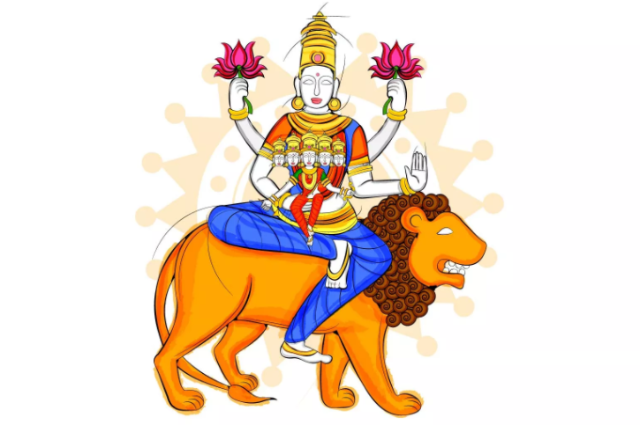
The day of Panchami or the fifth day of Navaratri is dedicated to the Skandamata incarnation of Devi Durga. Skandamata is depicted with four hands and three eyes riding on a ferocious lion and holding infant Skanda or Kartikeya in her lap. Two of her arms are attributed with lotus flowers; one hand is in the gesture of bestowing boon and the fourth one is engaged in holding Her son Kartikeya. She is the symbol of strength and prosperity. The colour of the day is grey symbolizing a vulnerable mother who is subject to change into a stormy cloud if the situation demands. Besides, yellowish green symbolizing prosperity and vegetation is also considered the colour of the day. She may be identified with Ceres, the Roman goddess of agriculture, grain and the affection of the mother.
6. Sasthi:
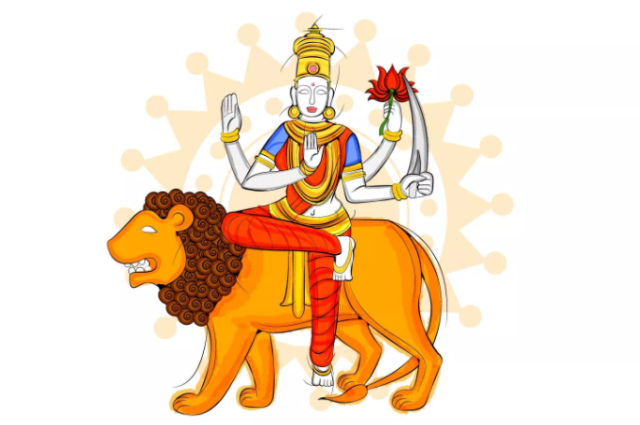
The sixth day of Navaratri is dedicated to the incarnation of Katyayani, the daughter of Katyana Rishi. She was created out of the anger of Brahma, Vishnu and Shiva and other gods. According to Vamana Purana, all the energies of the gods in the form of rays crystallized in the hermitage of Katyayana Rishi. Devi Katyayani manifested with eighteen arms and effulgence equal to thousand suns. She was bestowed with multifarious divine arms and articles. Seeing Her refulgent beauty, the Mahishasura was so enamoured that he proposed Her to marry. Then Devi Katyayani challenged him in a battle. After a grim battle, She dismounting from Her lion, decapitated the head of Mahishasura. That earned Her the name Mahishasuramardini. The colour of the day is orange representing sage as goddess Katyayani was the daughter of Katyayan Rishi.
7. Saptami:
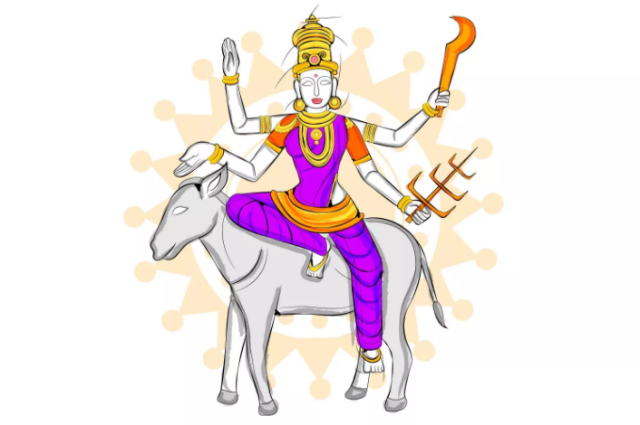
On the day of Saptami, Kaalratri, another incarnation of Devi Durga is worshipped. The goddess in this incarnation is believed to be the destroyer of ignorance and darkness. From Her three eyes emanate rays like lightning and flames of fire come out of Her nostrils while breathing. Other extended destructive forms of Kaalratri are Mahakali, Kali, Rudrani, Chamunda, Chandi et al. She killed the demon named Raktabeej who was bestowed with a boon from Brahma that he would multiply by thousands if a drop of his blood touched the ground. Therefore the Goddess sucked and licked his blood before touching the ground. The Goddess Kalratri is depicted to have four hands with pitch dark complexion symbolising darkness of the night. She is seated on a donkey, Her divine vehicle. On this day blue, red and white colours are considered auspicious.
8. Ashtami:
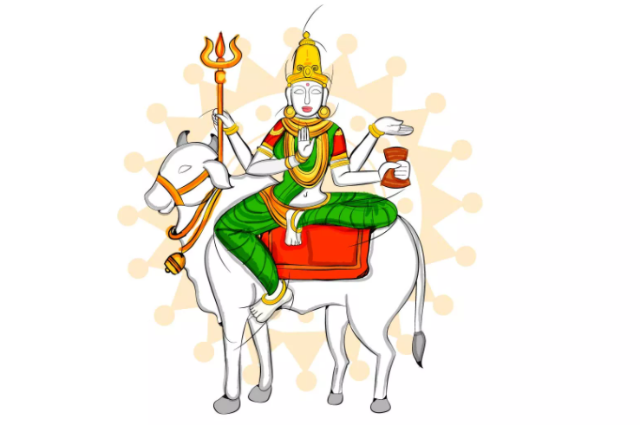
The eighth day or Ashtami of Navaratri is consecrated to Mahagauri avatar of Goddess Durga. She is depicted with four hands. Three hands are adorned with a trident, a lotus and a dambaru (a kind of small drum) and the fourth hand is in a blessing gesture. She is attired all white. Her divine vehicle is a white bull. When Parvati was unable to defeat the demon brother Shumbha and Nishumbha, Lord Shiva guided by Lord Brahma, turned Her complexion into black. Later Parvati performed an austere penance and got back Her fair complexion. Another story depicts that the sacred water of Ganga cleansed all Her dirt and turned Her white complexioned. The colour of Ashtami is pink symbolizing love and compassion.
9. Navami:

On the day of Navami, the ninth day of Navaratri, Siddhidatri avatar of Devi Durga is adored. The very name Siddhidatri implies the bestower of all types of siddhis i.e. all the divine aspirations of Her devotees. In this incarnation, She has four hands with a blissful happy enchanting disposition. Removing all types of ignorance She bestows Her devotees with the divine knowledge to realize the supreme Brahman. She is portrayed as sitting on a lotus. Her four hands are adorned with a lotus, mace, Sudarshan Chakra and Shankh. She is surrounded by gods, saints, yogis, Yakshas, Gandharvas, Asuras to worship Her. She is the Goddess Mahashakti who gave birth to the Trinity i.e. Brahma, Vishnu and Shiva. She decided and directed their duties in the universe. She coalesced half of Shiva and Parvati’s bodies and converted to become Ardhanarishwar for the creation of all life forms. On the ninth day, the devotees break their fast after worshipping different forms of Goddess Durga.
Vijaya Dashami:
The day of Vijaya Dashami or the very day after Navratri is celebrated as the day of victory of the ‘good’ over the ‘evil’ attained by Maha Shakti. Devi Durga represents ‘good’ i.e. Dharma or righteousness. On the contrary, Demons like Ravana, Kumbhakarna and Indrajit represent ‘evil energies’ i.e. Adharma or sinfulness. On the day of Vijaya Dashami, the darkness of ignorance is illuminated by the light of divine knowledge and enlightenment.
